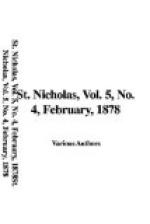“Ah, master!” he whispered; “climb down the rock to-night, and I’ll show you the way home.” And he disappeared.
This visit braced up the old man’s courage, and when the mother-bird came home he calmly told her he thought he’d sleep at the foot of the rock that night; and she unsuspectingly took him in her talons and dropped him gently on the ground.
As soon as she had gone, the old man looked all about him, and called “Tabby, Tabby,” very softly. Tabby came out from under the roots of a tree and bounded on his shoulder, and told him how sorry the cow was, and how she was waiting in a thicket ready to carry him home, if he wanted to go.
Of course he wanted to go, and in less than a jiffy the cow had come out from her hiding-place, had cried a little, and had taken the old man on her back, and started full speed down the mountain, with the cat tearing after her.
It was a long way to the old man’s house, and they reached it just tired out. Of course, they got something to eat, and then they went to bed and slept right through two days; but on the morning of the third day they got up as merry as crickets, and, after a hearty breakfast, they agreed to live together for the rest of their lives. And they have lived ever since in perfect harmony.
THE RAID OF THE CAMANCHES.
BY THE AUTHOR OF “WE BOYS.”
Fred Hart, who was the eldest son of a country clergyman, and preparing for college at Whitford Boys’ Academy, was known at that classical institution as a “dig,” because he “dug” into his books and studied hard. His room-mate, Neal Howe, an orphan, dependent upon his own exertions, was styled a “digger;” and as both lads were rather dark, it was but a step for those wicked upper-story boys to stigmatize them, “Digger Indians!”
This term was gradually extended to include all the boys in the second story, for they were all hard students. The “Diggers” retaliated mildly by styling their upper-story neighbors, “Camanches.”
The Camanches perpetrated all sorts of schoolboy atrocities on the Diggers, but, above all things else, they burned for a pillow-fight. In vain they challenged the Diggers to combat. Those law-abiding savages declined, though well aware of thereby falling into contempt on charge of cowardice.
Unmistakable indications were soon apparent that the Camanches meditated an attack.
The north wing was intended to be fire-proof, and each story was separated from the main building by iron doors which usually were fastened back by staples. The Camanches reasoned that these doors might be as effectual in shutting off teachers as fire; and the staples in both the second and third stories were one day withdrawn, so that these doors could be easily closed.
Scouting parties reported that the Camanches were getting ready the war-paint,—i.e., the burnt cork,—and one ferocious savage had intimated that they should spare neither age nor sex.




